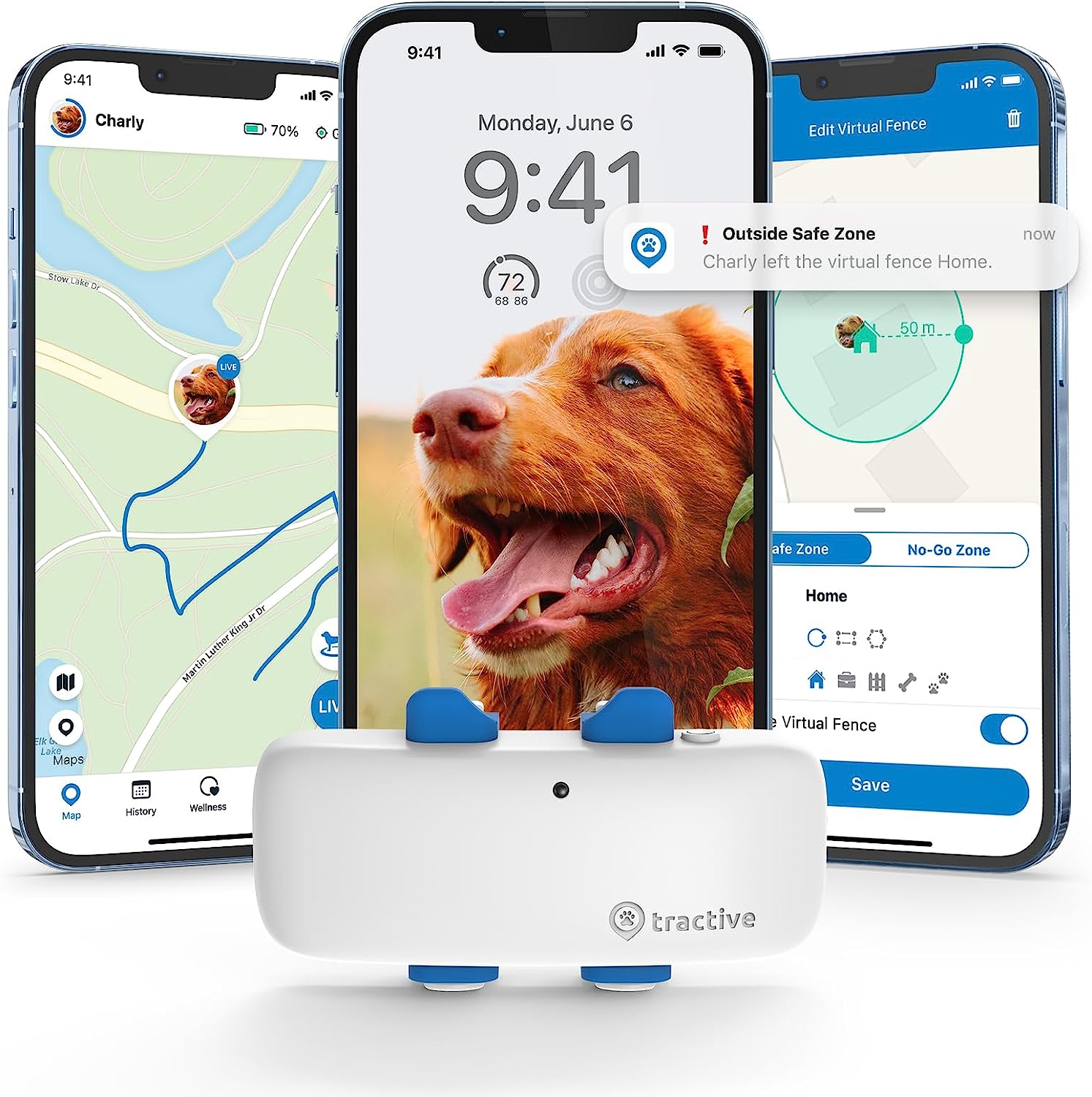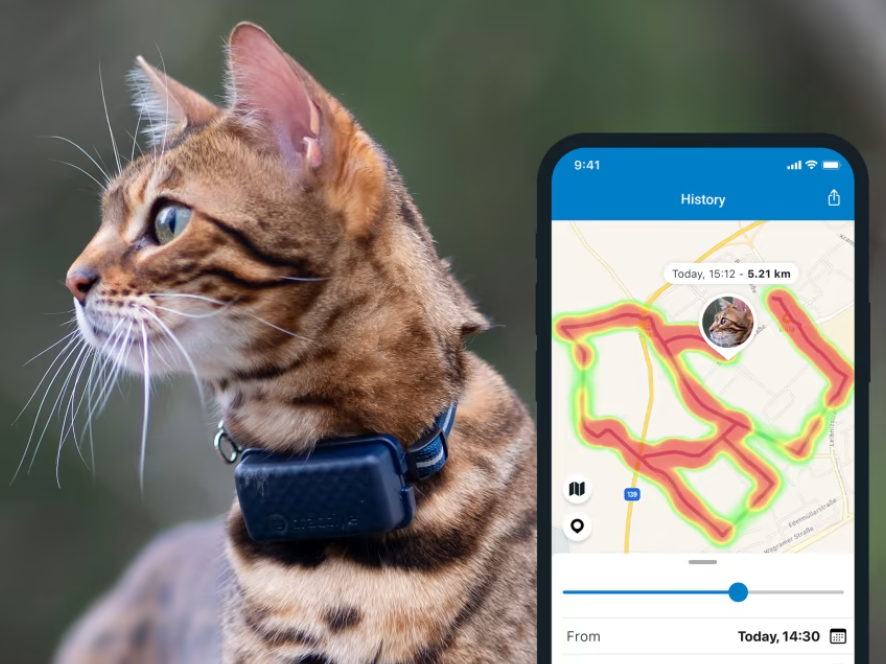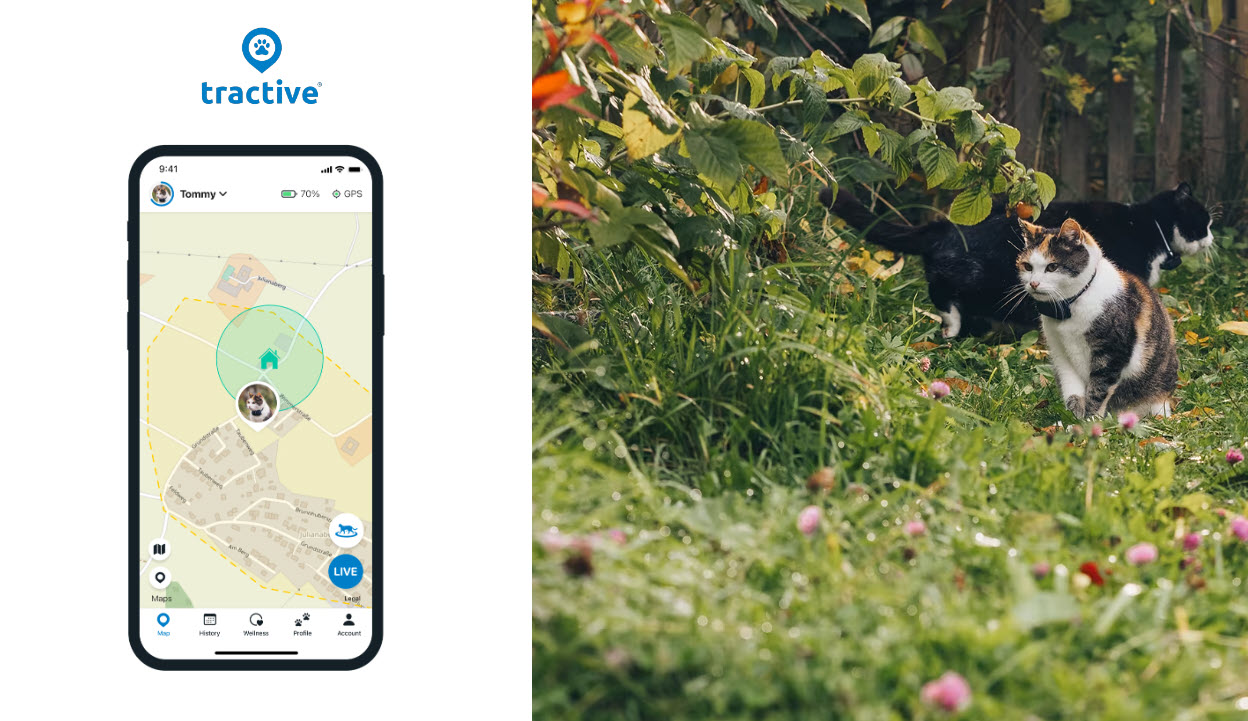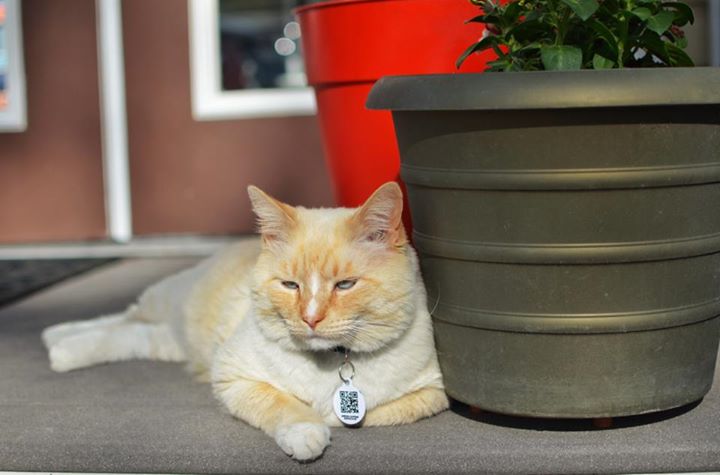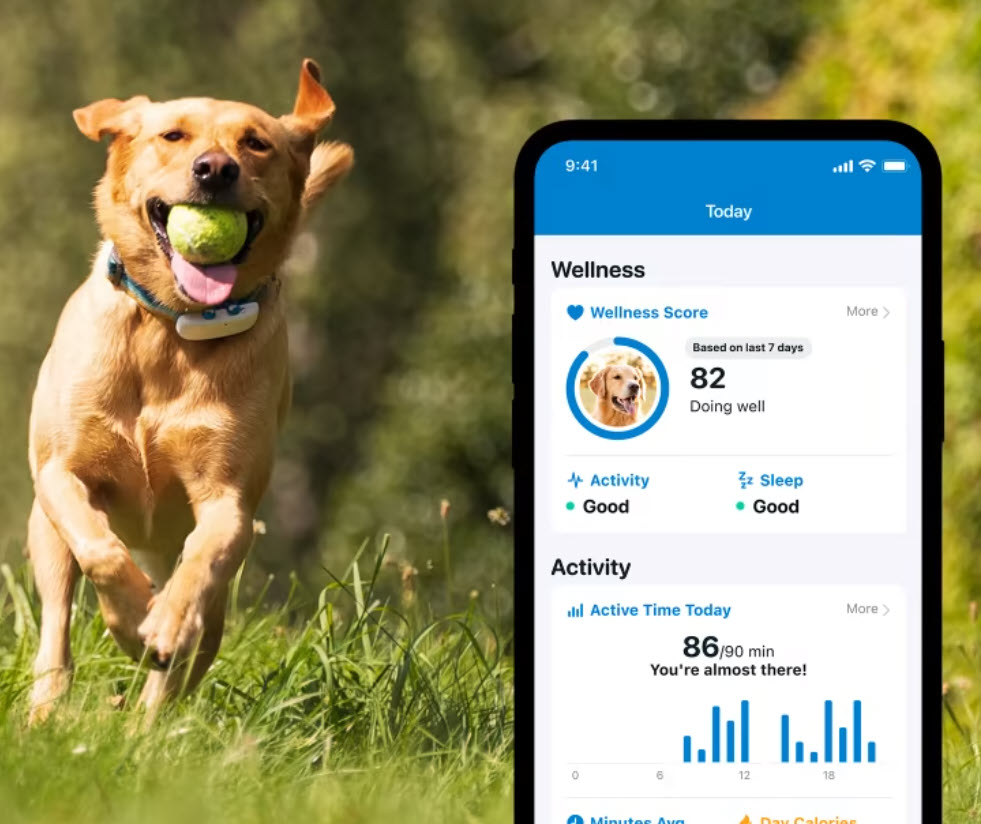Okay, are you sitting down? If you are a long-time PetHub fan, you know that we're not known for recommending using GPS pet tracker collar devices. Below, we're going to tell you why we recently started to recommend GPS trackers (at least some of them). To be fair, we're also gonna outline when we DON'T recommend them. Gotta keep things real, ya know?
Fair warning, though, this isn't one of those articles that tells you how we've determined the "best pet trackers" and ranks them in different categories. Instead, you'll read our honest assessment of the tracking device category as a whole. Sure, we'll mention some brands, but it will be in the mode of explaining how to use these devices as a lost pet prevention and recovery tool.
As the founders of Lost Pet Prevention Month, we aim to stay true to our mission of preventing lost pets from happening and helping a roving pet to find its way back to its humans ASAP!
Why We Haven't Been Big Tracker Fans in the Past
Years ago, we were the first to hit the market with a Bluetooth tracker just for pets. However, after about 18 months of rigorous testing, we shelved it and decided to focus on non-electronic identification products. Why?
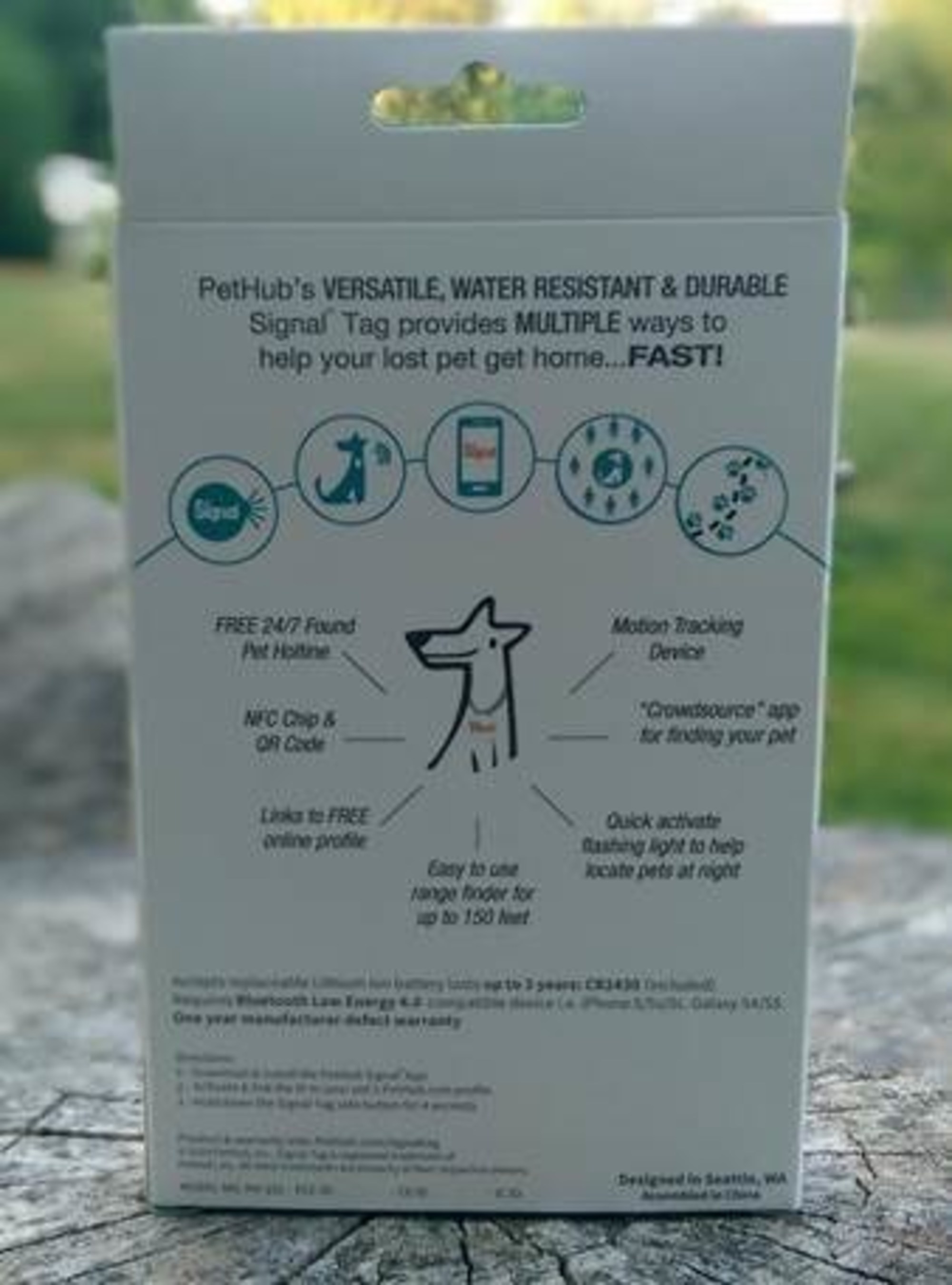
We didn't feel the dog GPS tracker technology was good enough to get pets home reliably. Battery life, durability, lack of common use (we'll get more of why that is important later), location accuracy, and issues around signal interference are just a few of the reasons we stepped away from adding an electronic tag to our catalog.
Another big detractor is that folks tend to rely on just pet GPS trackers to get their pets home when they have one. Things like a microchip and visible ID tags on the pet are often ignored and not kept up-to-date or flat-out not used at all. If we had a dollar for every time we heard, "I don't need a tag for my pup, he wears a GPS pet tracker," we'd be mega rich.
Why We've Changed Our Tune (Sorta)
As pet parents ourselves, we want nothing but the best for our furry friends. From their nutrition to their activity levels, we strive to ensure they have a happy and healthy life! With modern technology advancing rapidly, electronic collar devices are improving every year. Battery life and range have improved, and devices are smaller and more durable, too.
Perhaps the biggest shift for us, however, came when the folks at Tractive started chatting with us about how important it was that pet parents had a comprehensive, multi-layered approach to lost pet prevention and recovery. They got it.
They understood that things like microchips and ID tags simply cannot be tossed away in favor of a GPS tracker. Instead, a dog GPS tracker can greatly enhance and improve lost pet prevention and recovery. But GPS dog trackers should never be a stand-alone solution.
We decided to look further at Tractive...and we liked what we saw. Notice, for example, that, unlike most GPS dog tracker websites, there are pictures on their website of pets wearing ID tags on their collars. Plus, they have prominent blog posts about the importance of ID tags and microchips. They GET it.
Still, it can be tough to determine whether or not a collar like theirs is the optimal option for your pup. Let us help you decide what’s best for them!
Here’s an overview of all pros (and cons) that come with using these types of collar devices — like Tractive and other GPS tracking collars to Bluetooth "trackers" — plus advice on how each works and when each should be used.
It must be noted that the following Do's and Don'ts are from PetHub's Lost Pet Prevention perspective: you wouldn't try to build a house with only a single hammer and nail expecting to finish with a solid, well-built shelter that would keep you warm and dry in all weather.
Why would you rely on just an electronic device like a GPS tracker to keep your pet from running away? You shouldn't. Your lost pet prevention tool kit should be filled with many tools to give your pet comprehensive coverage and protection.

Location, Location, Location
If you're like most pet parents, you wanna know dog's location is at all times and be confident they are safe. This desire has led to a surge in the popularity of pet trackers. These devices are becoming a staple for pet parents everywhere, thanks to advancements in technology.
With the rise of GPS and Bluetooth technologies, it's now easier than ever to keep tabs on your cat or dog’s location, even when you're not physically with them. It's peace of mind, knowing we can keep an eye on our furry friends, even when we can't be next to them. So, whether your pup is exploring the backyard or you're out hiking together, these collars make it easy to keep tabs on your pet's whereabouts.
DO Get Location Updates of Your Pet with a GPS Pet Tracker
Honestly, the geek in us just LOVES watching our furball's icon move around the yard on a tracking collar app. It's like a live-action pet video game, but better because it's real!
With some GPS pet trackers, we can track our pets in real-time, which means we see where they are at this very moment. No more guessing if they're chasing squirrels or lounging in the sun like Charlie below.
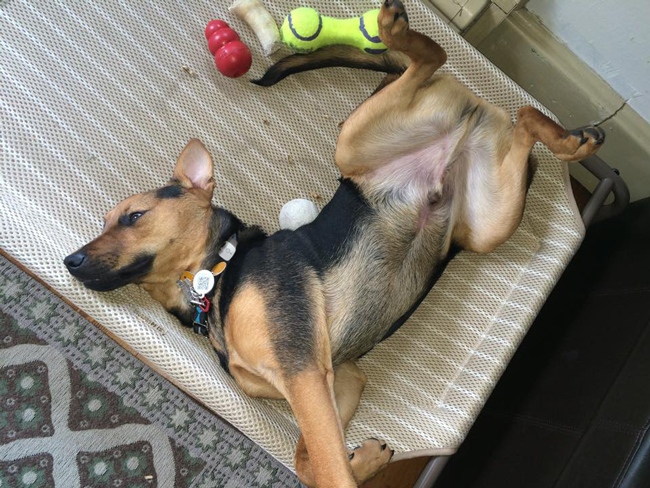
DON'T Expect to Get True Real-Time Location Tracking with All Devices
While many dog GPS trackers claim to offer "real-time" tracking, it's important to understand that this doesn't always mean instantaneous updates. Some collars may have a significant delay (like 10 to 20 seconds) in transmitting location information due to factors like signal strength or the quality of the GPS connection types used.
This means there could be a lag between when your pet moves and when you see their location update on your device. Really good devices, like those from Tractive, do update reliably every 2-3 seconds. In our books, that's as close to "real-time" as you can get.
Additionally, environmental obstacles like tall buildings or dense foliage can interfere with the GPS signal, potentially causing inaccuracies in your pet's reported location.
Even the best device might experience occasional disruptions or delays, so it's essential to consider this when relying on these devices for your pet's safety and whereabouts.
DO Understand What TYPE of GPS Tracking the Collar Uses
![]()
DO Expect Satellite GPS Trackers to Work Well in Rural Areas
Satellite GPS dog collars offer a worldwide reach, making them an ideal choice for pet owners in rural or less populated areas, or folks that do a lot of hiking and camping like Jenni and Doug below.
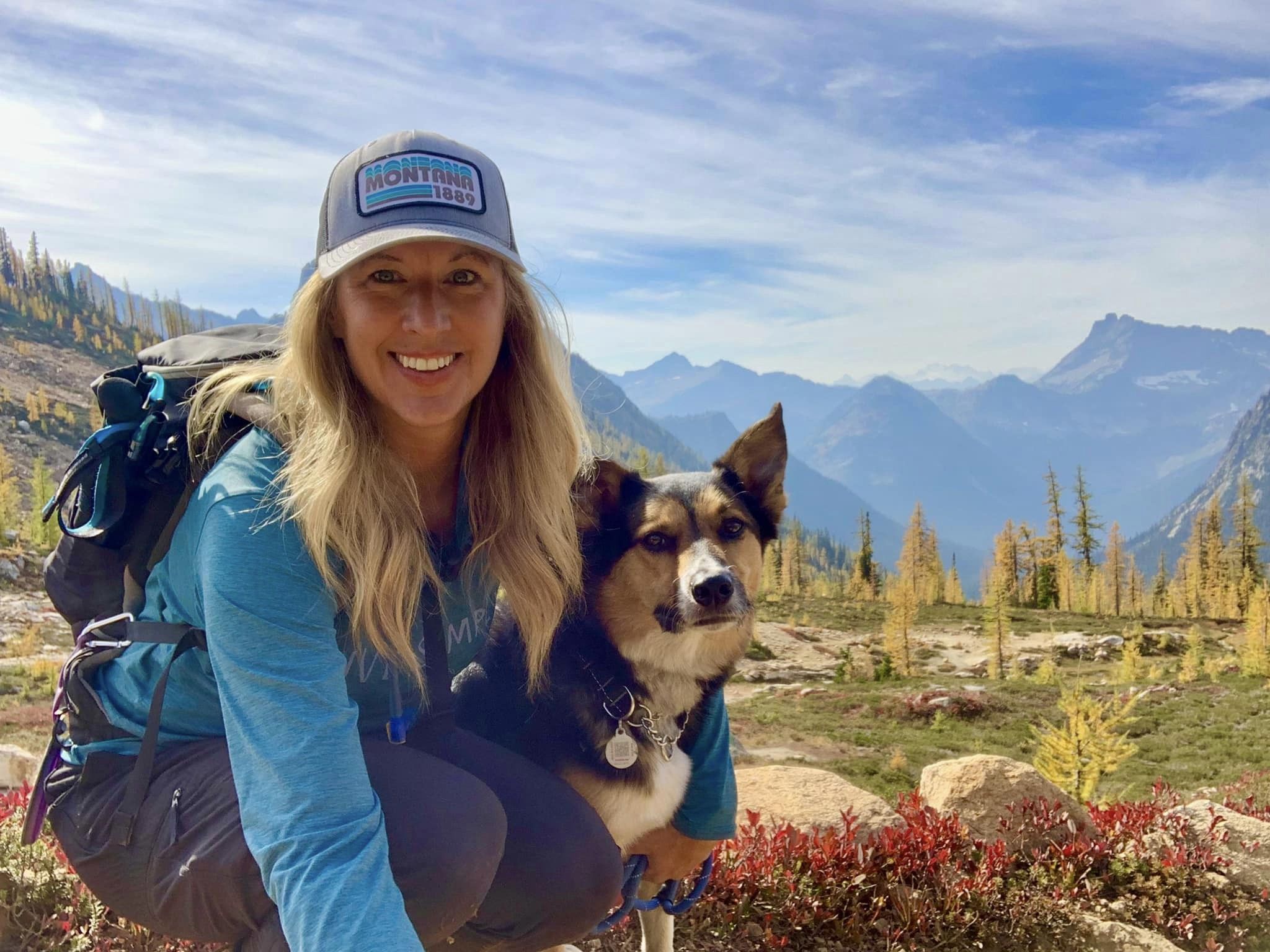
These collars work by connecting to satellites, allowing them to track your pet's location regardless of how remote it might be. They offer high location accuracy and reliability, ensuring you can locate your pet swiftly.
DON'T Expect a Satellite GPS Tracker to Work Flawlessly, Though
Their performance can be hindered by physical obstacles like buildings or heavy foliage, which can block satellite signals. Moreover, the constant connection to satellites can lead to quicker battery drain (more on overall battery issues later).
DO Expect Cellular a dog GPS Tracker to Work Well in Urban Areas
On the flip side, cellular GPS dog collars use mobile networks to track your pet. In areas with strong cellular service coverage, like many urban settings, these collars can offer precise tracking. They also tend to have longer battery life as they connect to cell towers only when necessary.
Tractive GPS pet trackers leverage a variety of connectivity options to ensure seamless tracking of your furry friends. They primarily utilize LTE-M cellular networks, which provide wide coverage and reliable data transmission, allowing you to monitor your pet's location in real-time.
In addition, they also use Bluetooth and Wi Fi for added flexibility and precision in location tracking. These combined technologies work together to offer pet parents peace of mind, knowing they can locate their pets quickly and accurately when needed.
DON'T Expect Cellular-only GPS Trackers to Work Well Outside of Urban Areas
The effectiveness of cellular-only dog GPS trackers is heavily dependent on the strength of cellular networks. In areas where cell coverage is weak or non-existent, such as remote or rural areas, these collars may not function optimally. Therefore, while cellular-only versions offer an excellent solution for pets in urban areas, they may fall short in more remote locations.
In general, a GPS tracker on your dog's collar is going to do a great job of location tracking. Because they all now have apps for your mobile device, you'll have an easy way to keep tabs on your pet's outdoor adventures with the terrific location history features of most GPS tracking device apps. Plus, you'll know pretty instantly if your dog escaped your yard, their safe zone, or home when you are not with them.
All Charged Up and Raring to GO
Have you ever started a big day of fun with a fully charged phone and after just an hour of following Google Maps to a new beach you're checkin' out, your batter is at 60%? It sucks, doesn't it? That's the kind of experience you might face with certain electronic pet collar devices too. Just as your smartphone's battery life depends on its usage, so does the battery life of your pet's collar device. The type of device plays a major role.
DO Expect a True GPS Tracker to Need Frequent Recharging
GPS pet trackers that need constant communication with satellites or cell towers may drain the battery quickly.
Satellite GPS trackers, for instance, are always connected to satellites to provide accurate location details. This constant connection, while ensuring precise tracking, can lead to a rapid battery drain. On average, these collars may need to be recharged every few days, depending on the brand and model.
On the other hand, cellular units connect to cell towers only when necessary, which can extend the battery life. These collars often hold a charge for a longer period, sometimes even up to a week or more.
Regardless of which type of dog collar you choose, it will be important to have a routine in place for recharging the collar to ensure your pet is always protected.
Consider setting a reminder to charge the device, and if possible, choose a time when your pet is less active or within your sight. We suggest you take the opportunity for a nice pup-snuggle on the couch while watching movies and eating snacks while the GPS tracker is on the charger.

DO Expect a Bluetooth Tracker to Have a Longer Battery Life
Bluetooth trackers, on the other hand, which connect only within a specific range, are known for long battery life (usually). Bluetooth technology and battery usage have improved greatly over the years. These devices use less power as they only connect when the paired device is within tracking range.
Certain factors can cause the battery to run down faster. For example, if the collar is constantly trying to connect due to being on the edge of its tracking range, it can drain the battery. Additionally, frequent use of features like live-tracking or sound alerts can also impact battery life.
Most Bluetooth collars come with a low-battery alert feature, notifying you either through an app or a light indicator on the dog collar itself. It's important to pay attention to these alerts to ensure your pet's safety.
![]()
Most Bluetooth trackers use replaceable batteries, keep spares handy and change them as soon as you receive a low-battery alert. Almost all Bluetooth trackers use coin-sized watch batteries (often a CR2032) and they are pretty cheap and easy to replace.
A word of caution though (from personal experience) -- some devices use a special tool to open them and losing that tool means you likely can't open the darn thing without breaking it. Pro tip: tape the battery changing tool to the spare batteries.
DO Consider a Cat-specific GPS Tracker for Outdoor Access
Kitties
A GPS tracker attached to your cat's collar is a wonderful tool for outdoor cats and cats with outdoor access. Let's face it though, most GPS collars were designed as dog trackers, and not really meant for super small pups or cats.
Over the years, GPS trackers designed specifically for cats have made significant strides. They are now smaller, lighter, and more tailored to the unique needs of felines, ensuring they don't hinder your cat's natural movements or cause discomfort.
Take Tractive's CAT mini for example. This particular GPS tracker is lightweight and comes with a weight-adjustable collar, making it suitable even for smaller cats.
It offers real-time tracking on your handheld device, allowing you to keep an eye on your feline friend's whereabouts. This can be particularly useful if your cat is an adventurer, often exploring beyond your backyard.
The location history alone allows you to really understand your cat's territory. The more you "get" what your cat is doing during her outdoor adventures and see where she's hanging out using a smart tracker, the better your lost pet prevention plan can be. Plus, you can set up the cat's safe zone to match her territory and receive alerts when she goes beyond it.
While these devices can provide peace of mind, it's crucial to remember that they're just one part of a comprehensive approach to pet safety. Microchips and visible ID tags remain essential components of lost pet prevention.
A microchip provides a permanent form of identification that can't be lost or removed, and a visible ID tag instantly allows anyone who finds your cat to contact you. By combining a GPS tracker with these other forms of identification, you're taking a well-rounded approach to ensure the safety of your outdoor-exploring kitty.
DO Always ALWAYS Have a Tag on Your Pet's Collar
Dear pet parents, please listen and believe us when we say: "a tracking collar is NOT reliable enough to get your pet home if they run away." While these devices can help you monitor your dog's location, they are not infallible.
For instance, a dog on the run can cause the battery to drain faster than under normal use. The constant movement, coupled with the frequent use of live tracking, can significantly reduce the battery life on a GPS dog collar.
Unpredictable battery life alone should be a wake-up call for all pet parents to always have double coverage. This means pairing a tracking collar with a good ID tag, preferably a digital ID tag like PetHub.
An ID tag is a simple and effective way to ensure that if someone finds your pet, they can easily contact you. It's a low-tech backup plan that doesn't rely on batteries or satellite connections.
So, while GPS tracking can be an excellent tool for keeping tabs on your pet, they should not replace traditional ID tags. Remember, technology can fail, but an ID tag remains visible and accessible, providing an additional layer of protection for your furry friend. So, ALWAYS have a tag on your pet's collar. It's an easy step that can make a huge difference in getting your lost pet back home safely.
DON'T Expect a Bluetooth Tracking Collar to Truly "Track" Your Pet
Bluetooth trackers are not true GPS trackers. Sure, Bluetooth technology has come a long way in the last decade, but they still are not using the global positioning system to find your lost pet.
DON'T expect a Tile or AirTag on your cat or dog's collar to give you an actual, near-to-real-time location of your pet like a Tractive pet GPS tracker or Whistle Go would. Bluetooth pet collars typically have a much shorter range than GPS trackers, often limited to about 100 feet. This means if your pet wanders beyond this range, you won't be able to track them using your device.
Additionally, these trackers can't provide real-time updates on your pet's location. They only work when your pet is within the Bluetooth tracking range, so they're best for keeping tabs on your pet when you're both at home or in a small area.

If your pet is a wanderer or you live in a large, open space, a Bluetooth tracker may not provide the coverage and long-range tracking capabilities you need. Before we start getting angry DMs from an AirTag owner or a Tile user that found their missing cat with the same Bluetooth tracker that helps them find their keys, know that we aren't saying DON'T use Bluetooth tracker devices.
While they can be helpful tools for preventing lost pets, Bluetooth trackers just don't offer the same level of security and peace of mind as real-time GPS trackers (or a smart tag like a PetHub Get Me Home Club ID).
DON'T Expect a Bluetooth Tracking Device to Be a Reliable Way to Get Your Lost Pet Home
Okay, maybe we are gonna say "don't use most Bluetooth tracker devices." But we have good reasons to say that, so hear us out. Devices like Apple AirTags and Tiles were designed to track inanimate objects like keys or bags, not living creatures such as our furry friend. We repeat they are not a pet tracker. Using them for pet tracking can come with a host of issues and potential dangers.
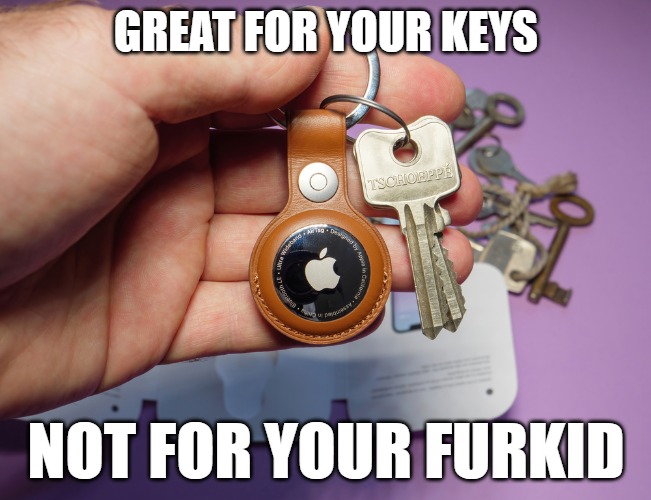
The primary drawback is that these devices rely on a Bluetooth connection with your smartphone, which has a limited range. If your pet wanders beyond this range, the device becomes essentially useless in tracking them.
Moreover, they do not provide live tracking or send alerts when your pet leaves a designated area, features that are often vital when trying to locate a lost pet. There's also a risk of these devices being easily dislodged from the dog collar, leaving them untraceable.
There are, however, Bluetooth devices specifically designed for pets. These devices are more reliable than general-use Bluetooth trackers as they come with features tailored for pets, such as secure attachment methods, waterproofing, and community alerts.
DO Choose a GPS Tracking Device Designed for Pets (and ONLY Pets)
Look, we understand that companies need to diversify their product lines. Once they've developed a super slick GPS technology device, they want to spread the glory of that tech everywhere to get maximum return on their investment.
However, when it comes to safeguarding your beloved pets, it's essential to opt for devices explicitly designed for them.

GPS trackers and Bluetooth devices not specifically built for pets might lack the necessary features for effective lost pet prevention. They may not be adequately durable or comfortable for your pet, and they might not include essential functions like real-time tracking or safe zone alerts. Moreover, these devices don't usually come with software tailored to assist pet parents in emergency situations.
On the contrary, devices like Tractive GPS pet trackers are meticulously crafted with pets' needs in mind. They are robust, and comfortable, and offer features that are genuinely useful for pet parents. The supporting software provides tools such as real-time tracking, safe zone settings, and activity monitoring.
These pet-specific trackers offer far more value to pet parents than a general-purpose device designed for tracking packages, bikes, keys, or even kids. Remember, when it comes to your pet's safety, it's worth investing in a device that's designed solely with an animal's welfare in mind.
DO Realize That Your Lost Pet Will Always Rely on the Kindness of Strangers
DON'T Expect That Every Stranger Will Use the Same App
Though they may provide a better option than general-use Bluetooth trackers, even pet-specific Bluetooth tags still do not offer the same level of reliability as GPS devices or smart ID tags like PetHub.
Why? All Bluetooth tracking devices operate on a crowd-sourced network, meaning they rely heavily on other people using the same app for their tracking capabilities. When your pet, equipped with one of these devices, moves beyond your device's Bluetooth range, the device will send out a signal that can be picked up by other smartphones using the same app within its vicinity.

This means that if your pet is lost, you're essentially depending on strangers who happen to be using the same app and are currently near your pet. If they're not in a densely populated area or an area where few people use the app, the tracking capabilities can be significantly hindered. This reliance on others introduces a level of uncertainty and unpredictability that can make these devices less reliable for pet tracking.
DO Expect that Strangers Will Likely Interact With Your Lost Pet
In contrast, pet-specific GPS tracking devices communicate directly with gps satellites or cell towers. They provide real-time location updates regardless of the presence or absence of other users in the vicinity. This makes them a more reliable choice for ensuring the safety and quick recovery of your pet.
Frankly, if it is a fully charged device that isn't facing interference or the challenges we've mentioned before, your pet might be found without involving strangers.
Might.
But here's the thing (whoa, PetHub's banging that drum again), most good folks see a dog with a collar and they're going to try to help it. So why not help them help you by having an ID on that collar with the GPS tracker?
DO Always Have an ID Tag On Your Pet (Yes, we're saying it again)
Speaking of external pet tags, particularly digital ID tags like PetHub, they definitely rely on the kindness of strangers. But the advantages of a visible pet tag are huge. They don't need batteries.
The information digital tags hold can be updated anytime, anywhere, and depending on the smart tag company you choose, hopefully for free (PetHub's pet profiles are 100% free). External ID tags work ANYWHERE and ANYONE can use them to help your pet get home quickly.
DON'T Just Rely on a Microchip as the Backup for a GPS Tracker
And microchips? Well, they rely on a WHOLE LOT of stranger kindness. And have a big ole' pile of things that have to go "right" to get your pet home quickly. We could go on and on about that, but we'll just point you to our Microchips 101 article instead.
Ultimately, your pet's safety is paramount, so again, we encourage using multiple methods of identification and tracking to provide the best assurance of their protection.
DO Expect Most Pet GPS Trackers to Have Fun Bells & Whistles
For this post, we're focusing on the tracking aspect of lost pet prevention that pet GPS dog tracker devices provide. And, to be fair, we've only really looked hard at a dozen or so devices on the market. New devices are coming out all the time and it's hard to keep track of them! (See what we did there?)
Each new pet tracker tool released has some PAW-some thing or another that tries to set it apart from the rest of the pack. Again, this article isn't about digging through that pile and ranking everything to share the best pet tracker. We just want to give you some guidelines on things to look for when it comes to lost pet prevention.
DO Expect Many Pet Trackers to Have a "Virtual" Fence Mode
(But DON'T expect it will keep your dog from ever running away)
We cover this topic more deeply in our How to Keep a Dog From Escaping the Yard article, but here's the TL;DR:
- Physical fences are the BEST prevention of a dog getting out of a yard
- Electronic & "Virtual" Fences don't prevent a truly determined dog from getting out of a yard
- Physical fences are the BEST prevention for keeping uninvited critters and people OUT of a yard
- Electronic & "Virtual" Fences don't keep uninvited critters or people OUT of a yard
- Electronic & "Virtual" Fence zones are a really powerful tools to use for many dogs, and can definitely improve your property's lost pet prevention
- Electronic & "Virtual" Fences often (but certainly not always) use static or "shock" signals from the collar device to the animal, and these can HURT and traumatize pets
Look, we get it. Sometimes a physical fence is just not possible. And in those cases, these collars can be the difference between a dog out of a chain or other kind of tie-out restraint.
DO Take Advantage of Activity Tracking
(But DON'T Expect All Activity Features to Be Equal)
While it's important to note that not all activity-tracking features are created equal, they can offer valuable insights into your pet's health and well-being.
For instance, sleep tracking can help you monitor your pet's rest patterns, which could be indicative of their overall health. Similarly, activity tracking can help you ensure your pet is getting enough exercise, and can even alert you to any sudden changes in their activity levels, which could signal a potential health issue.
The focus and quality of these features can vary significantly between devices. For instance, while Tractive pet GPS trackers include comprehensive wellness features in all their plans, other products like the FitBark GPS dog tracker and WhistleGo are primarily geared towards activity and wellness tracking, with lost pet recovery as an added benefit.
Therefore, when choosing a tracker, it's crucial to consider what features are most important to you and your pet. If lost pet recovery is your main concern, a device like Tractive might be more suitable. But if you're more interested in detailed activity and wellness tracking, FitBark or WhistleGo might be a better fit.
A good pet GPS tracker can provide peace of mind when it comes to protecting your furry family members. In addition to providing real-time location updates, they often include additional features like activity and wellness tracking that can be extremely useful for monitoring your pet's health. However, it's important to take into account how the device works and what other features are included, to get the most out of your purchase. With a little research and planning, you should be able to find a tracker that meets your needs and ensures the safety of your beloved pet.
At PetHub, our mission is to keep every family's pets happy, safe and home for the rest of their lives. Part of this goal is to make sure lost pets are quickly reunited with their owners. That's why we encourage pet parents to take a look at the su-paw affordable and paw-somely reliable Tractive pet GPS trackers. With both a PetHub digital ID tag and a Tractive GPS dog tracker (or mini Cat tracker) in your arsenal, you'll have the best chance of bringing home your lost pet quickly and safely.



